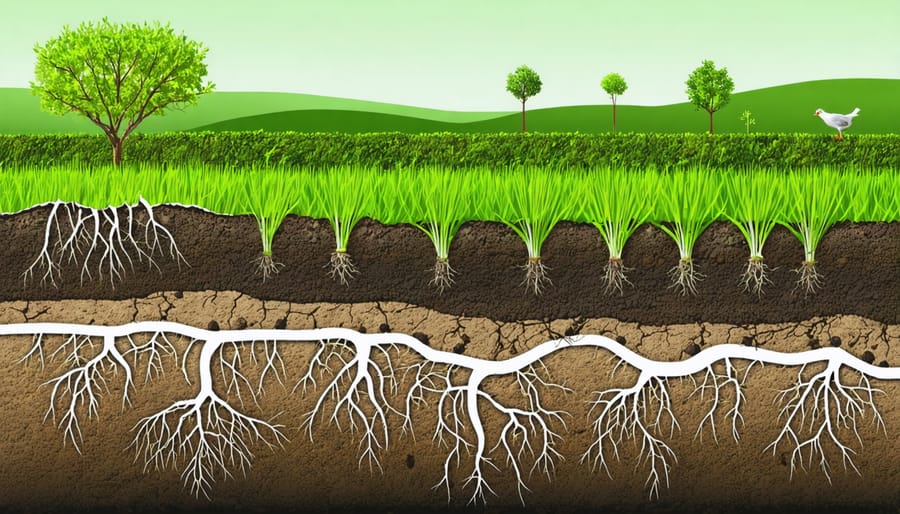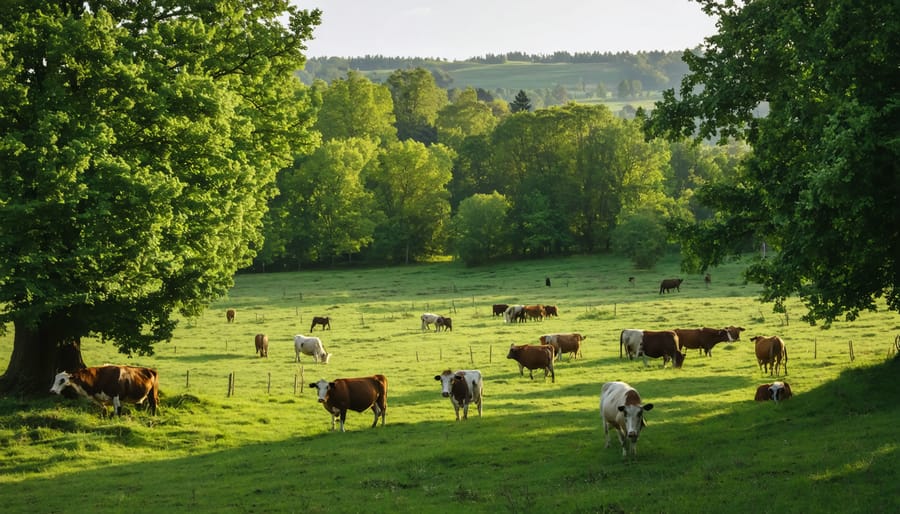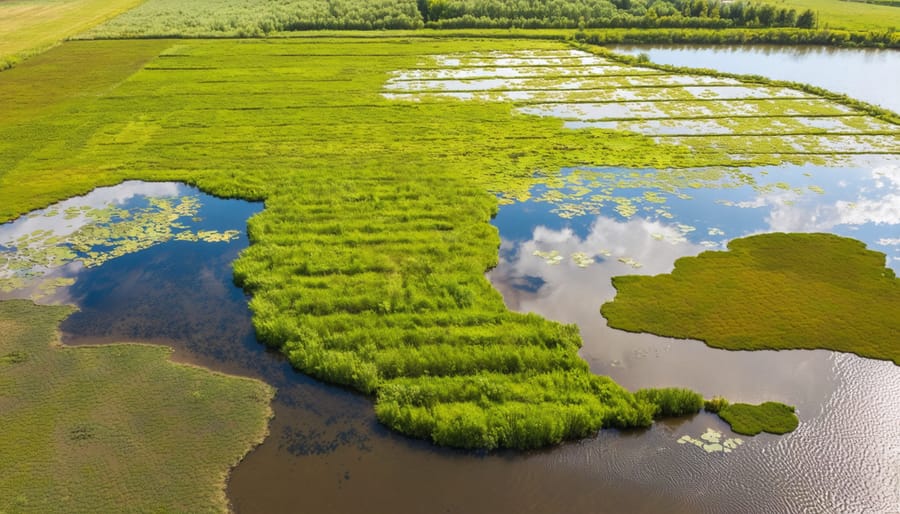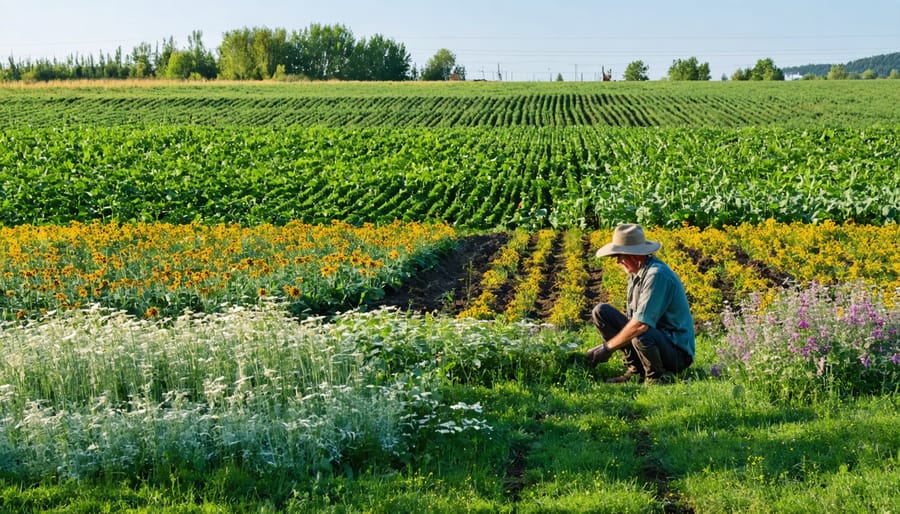Transform depleted farmland into a powerful carbon sink through proven carbon farming practices that boost both soil health and crop yields. Alberta farmers are leading the charge in soil carbon sequestration, storing up to 2 tonnes of carbon per hectare annually through strategic management techniques.
Perennial crops, with their extensive root systems reaching depths of 2-3 meters, naturally pull carbon dioxide from the atmosphere and lock it deep within the soil structure. This process not only fights climate change but also improves water retention, reduces erosion, and builds long-term soil fertility for sustainable farm operations.
Recent field trials across Alberta’s diverse agricultural zones demonstrate that integrating cover crops and reducing tillage can increase soil organic carbon by 15-20% within five years. These practices, combined with proper grazing management and crop rotation, create a resilient agricultural system that serves both environmental and economic goals.
For Alberta producers, the opportunity to participate in carbon markets while enhancing soil productivity presents a win-win scenario that’s reshaping our approach to modern agriculture.
Why Perennial Crops Are Carbon Champions
Deep Root Systems: Nature’s Carbon Storage
Deep-rooted perennial plants are nature’s carbon storage champions, extending their roots far below the surface – sometimes up to 2 metres or more. These extensive root systems play a crucial role in enhancing soil organic matter benefits and carbon sequestration.
Unlike annual crops that need replanting each year, perennials maintain their root systems year-round. This continuous presence allows them to build extensive networks underground, storing carbon in both living root tissue and through root exudates – the organic compounds that roots release into the soil. In Alberta’s agricultural landscape, native prairie grasses and legumes are particularly effective at this process.
When these roots naturally decompose, they leave behind channels that improve soil structure and create ideal conditions for beneficial microorganisms. These microbes further process the carbon into stable forms that can remain in the soil for decades or even centuries. Research from Prairie farms shows that fields with established perennial systems can store up to 2.7 tonnes of carbon per hectare annually – significantly more than annual cropping systems.
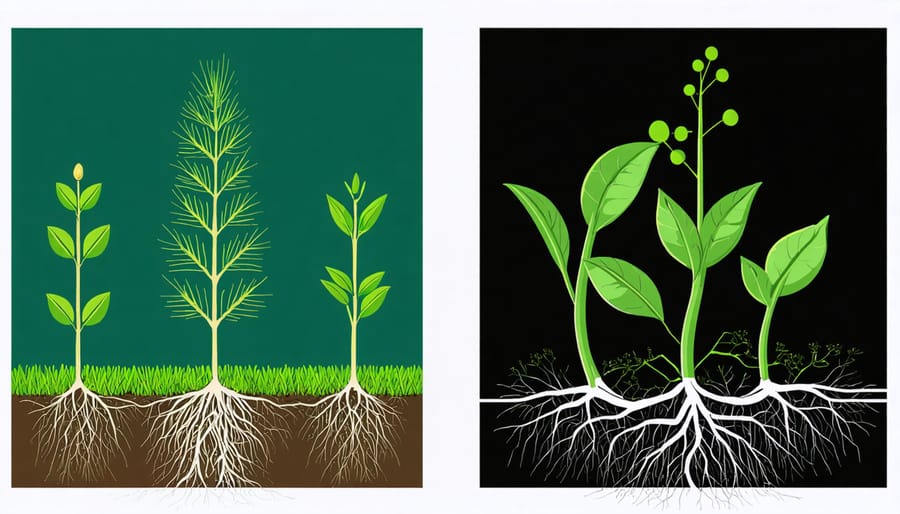
Year-Round Soil Coverage Benefits
Maintaining year-round soil coverage is one of the most effective ways to boost carbon sequestration in Alberta’s agricultural lands. When soil remains covered with living plants or crop residue throughout all seasons, it creates a continuous cycle of carbon capture and storage. During the growing season, plants actively pull carbon dioxide from the atmosphere through photosynthesis, while their root systems feed soil microorganisms and build organic matter.
In winter months, crop residue and cover crops protect the soil from erosion while continuing to feed soil biology. This constant plant presence helps build soil structure, increase water retention, and create a more resilient farming system. Many Alberta farmers have found success using winter cereals, fall-seeded cover crops, or leaving crop stubble standing to maintain coverage through our harsh prairie winters.
The practice also reduces the need for intensive tillage, as plant roots naturally condition the soil. This minimizes soil disturbance and helps keep captured carbon locked in place. For example, some local producers have reported improved soil health and reduced input costs after implementing continuous coverage systems, particularly in areas prone to wind erosion.
Alberta Success Stories: Perennial Systems in Action
Case Study: Mixed Grass Prairie Restoration
In 2018, the Thompson family farm near Red Deer, Alberta, embarked on an ambitious project to restore 160 hectares of degraded cropland to mixed grass prairie, implementing regenerative farming techniques that have since become a model for carbon sequestration in the region.
The Thompsons began by selecting a diverse mix of native grass species, including blue grama, western wheatgrass, and little bluestem, carefully chosen to match the local ecosystem. They partnered with the Alberta Conservation Association to ensure proper species selection and planting techniques.
After three growing seasons, soil testing revealed remarkable improvements. Organic carbon levels increased from 2.1% to 3.4%, representing approximately 12 tonnes of carbon sequestered per hectare. The prairie restoration also improved water retention, with soil moisture levels showing a 30% increase compared to neighboring conventional cropland.
The project’s success extended beyond carbon storage. The restored prairie now supports diverse wildlife, including native pollinators and grassland birds. The Thompsons have opened their farm for educational tours, sharing their experience with other Alberta farmers interested in similar restoration projects.
Key to their success was the careful monitoring and management during the establishment phase, including strategic grazing with cattle to stimulate root growth and enhance soil carbon storage. The project demonstrates how prairie restoration can effectively combine agricultural productivity with environmental stewardship.
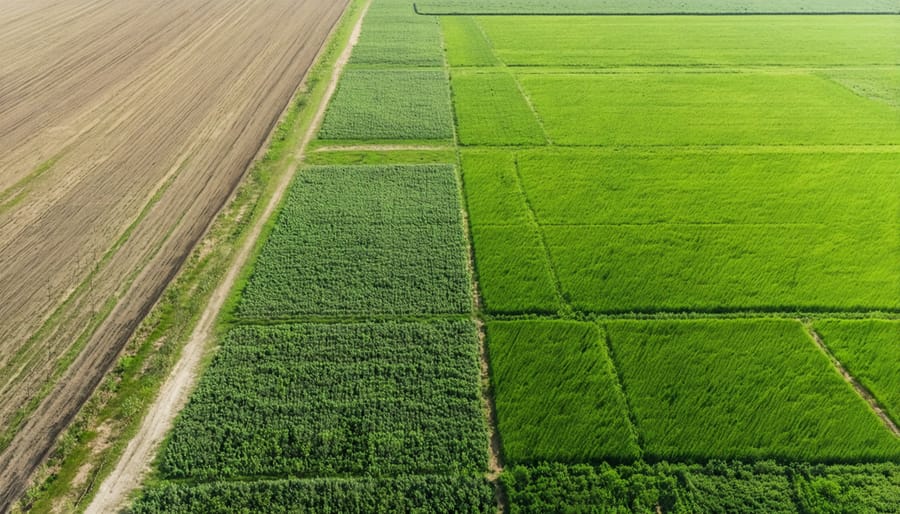
Case Study: Alfalfa Integration
The Johnson family farm in Red Deer County offers a compelling example of successful alfalfa integration for carbon sequestration. In 2018, Tom and Sarah Johnson transformed 80 hectares of their traditional wheat rotation into an alfalfa-based system, working closely with local agricultural extension specialists to optimize their approach.
The Johnsons implemented a three-year rotation, incorporating alfalfa for two years followed by canola. Their soil testing showed remarkable improvements: organic carbon levels increased from 2.3% to 3.1% within just three years. The deep root system of alfalfa, reaching depths of up to 2 metres, proved particularly effective at storing carbon throughout the soil profile.
Beyond carbon benefits, the Johnsons reported a 40% reduction in synthetic fertilizer use on subsequent crops and improved drought resilience. Their cattle operation benefited from high-quality hay production, while soil structure and water retention notably improved across the converted fields.
The financial impact was initially challenging, with establishment costs around $200 per hectare. However, by the second year, reduced input costs and premium hay prices resulted in a positive return on investment. The Johnsons also participated in Alberta’s carbon offset program, earning additional revenue through carbon credits.
This successful integration demonstrates how alfalfa can enhance both environmental sustainability and farm profitability when thoughtfully incorporated into existing operations.
Practical Implementation Steps
Selecting Suitable Perennial Crops
When selecting perennial crops for carbon sequestration in Alberta’s climate, focus on species with deep, extensive root systems that thrive in our unique growing conditions. Native grasses like Blue Grama and Green Needlegrass are excellent choices, as they’ve naturally adapted to our prairie ecosystem and can withstand both drought and cold temperatures.
Alfalfa stands out as a particularly effective option, offering both carbon sequestration benefits and valuable forage. Its deep root system, which can extend several metres into the soil, excels at storing carbon while improving soil structure. Consider mixing alfalfa with compatible grasses like Meadow Bromegrass or Russian Wild Rye for enhanced benefits.
For areas with adequate moisture, Red Clover and Sainfoin are strong candidates, offering excellent soil-building properties while providing quality livestock feed. These legumes also contribute to nitrogen fixation, reducing the need for synthetic fertilizers.
When planning your perennial system, consider your soil type and typical rainfall patterns. Sandy soils may benefit from drought-resistant options like Crested Wheatgrass, while heavier soils could support more moisture-loving species like Timothy grass.
For optimal results, establish diverse mixtures of perennials rather than monocultures. This approach not only maximizes carbon sequestration but also enhances resilience to weather extremes and provides extended growing seasons. Remember to account for your specific agricultural zone within Alberta, as growing conditions can vary significantly across the province.
Integration Strategies
Integrating perennials into existing farming operations doesn’t have to be an all-or-nothing approach. Many Alberta farmers have found success with gradual implementation strategies that maintain productivity while building soil carbon.
Start by identifying marginal areas of your farm that might benefit from perennial coverage, such as field edges, steep slopes, or areas with poor yield history. These locations can serve as pilot sites for establishing perennial grasses or legumes without significantly disrupting current operations.
Consider implementing strip cropping systems, where strips of perennials alternate with annual crops. This approach, successfully used by several Peace Region farmers, provides wind protection while gradually increasing soil organic matter. The width of these strips can be adjusted to accommodate your existing equipment.
Silvopasture systems have shown promising results in Central Alberta, combining trees or shrubs with forage crops and livestock. This multi-layered approach maximizes carbon sequestration while providing additional income streams through timber or fruit production.
For grain farmers, incorporating perennial cereals like Kernza can be an effective transition strategy. Start with a small test plot to learn management techniques before expanding. Local seed suppliers and agricultural extension offices can provide region-specific varieties suited to your soil conditions.
Remember to maintain detailed records of your integration process. This documentation helps track success and can be valuable for potential carbon credit programs or certification schemes. Connect with local farming networks to share experiences and learn from others who have successfully integrated perennials into their operations.
Measuring and Monitoring Success
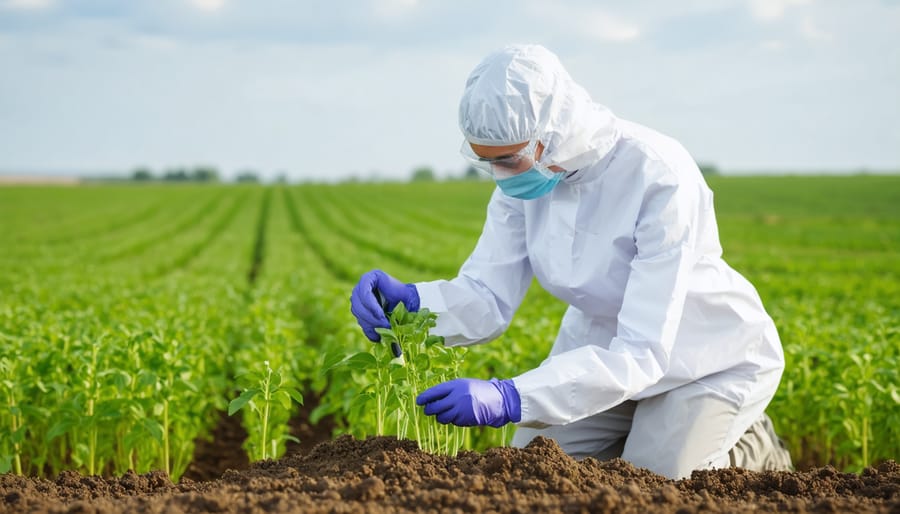
Soil Testing Protocols
Accurate soil testing starts with proper sampling techniques. For best results, collect soil samples in early spring or fall when soil conditions are relatively stable. Using a soil probe or auger, take 15-20 core samples from different spots across your field, focusing on areas with similar soil types and management histories.
Sample to a depth of 30 cm, dividing cores into 0-15 cm and 15-30 cm segments to track carbon distribution throughout the soil profile. Remove any visible plant material or stones before mixing the samples thoroughly in a clean plastic bucket.
Store samples in clean, labeled plastic bags and keep them cool during transport. For carbon testing, we recommend working with accredited labs that use the dry combustion method, which provides the most accurate results for total organic carbon content.
Consider testing annually during the same season to track changes effectively. Besides carbon content, request analysis for pH, organic matter percentage, and nutrient levels, as these factors influence carbon sequestration potential. Many Alberta agricultural extension offices can recommend qualified testing facilities and provide guidance on result interpretation.
Remember to maintain detailed records of sampling locations using GPS coordinates to ensure consistent monitoring over time.
Carbon Credit Opportunities
Alberta farmers can now participate in various soil carbon credit programs that reward sustainable agricultural practices. The Alberta Conservation Cropping Protocol offers credits for reduced tillage practices, while the Conservation Cropping Initiative provides opportunities for farmers implementing soil enhancement strategies.
Through these programs, farmers can earn between $15 and $30 per hectare annually, depending on their region and specific practices. The verification process typically involves soil testing every three to five years, with ongoing documentation of farming practices.
To participate, farmers need to register with approved aggregators like Carbon Credit Solutions or Farmers Edge. These organizations handle the paperwork, verification, and credit trading processes, making it easier for farmers to focus on implementation.
Recent success stories include the Mackenzie County Carbon Project, where over 100 farmers collectively earned more than $2 million in carbon credits through improved soil management practices. The program continues to expand, with new opportunities emerging as carbon markets develop and verification methods improve.
The implementation of perennial systems in Alberta’s agricultural landscape represents a powerful opportunity to combat climate change while building more resilient farming operations. Through the practices we’ve explored, Canadian farmers can significantly increase soil carbon storage while enjoying numerous co-benefits, including improved soil health, enhanced water retention, and increased biodiversity.
The evidence is clear: perennial systems can sequester between 0.5 to 1.5 tonnes of carbon per hectare annually, offering a sustainable path forward for our agricultural communities. Beyond environmental benefits, these systems provide economic advantages through reduced input costs and potential carbon credit opportunities through Alberta’s carbon offset program.
As we face increasing climate challenges, the time to act is now. Consider starting with a pilot project on a portion of your land, perhaps 2-4 hectares, to test these systems in your specific context. Connect with local agricultural extension services and fellow farmers who have successfully implemented perennial systems. Their experiences and insights can prove invaluable as you begin this transition.
Remember, every hectare converted to perennial systems contributes to building a more sustainable future for Canadian agriculture. By working together and sharing our experiences, we can create a network of knowledge and support that benefits both our farming communities and the environment. The journey to improved soil carbon sequestration starts with a single step – and that step can begin on your farm today.

